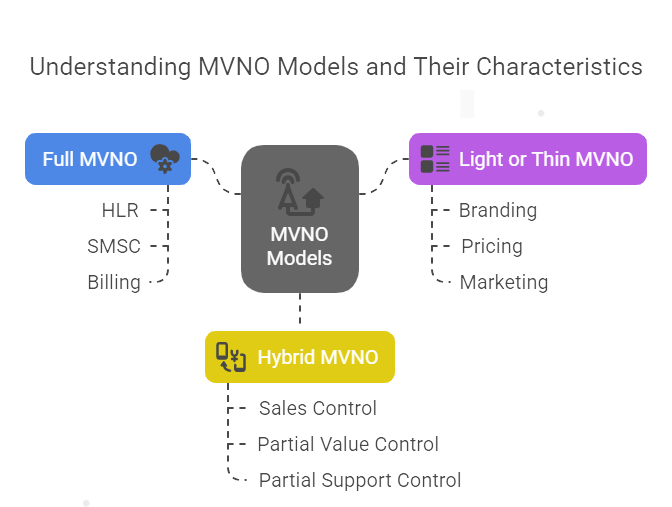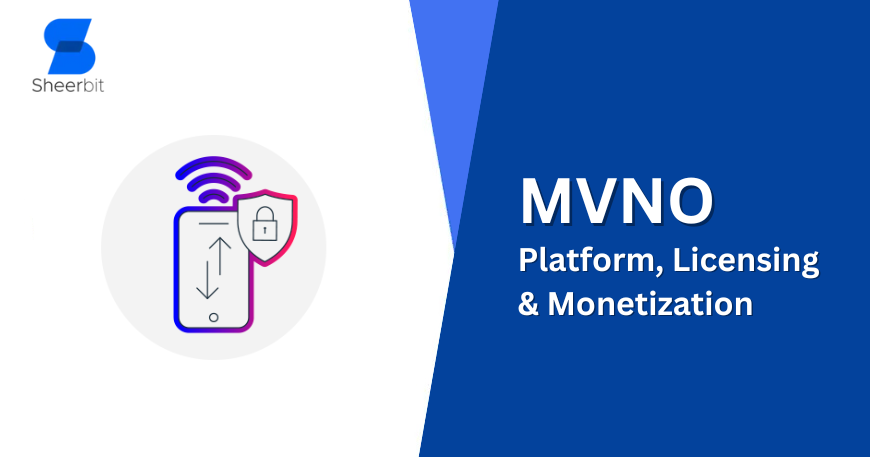The Mobile Virtual Network Operator (MVNO) market is booming due to improvements in telecom technology, demand for niche mobile services and the ever-decreasing barriers to entry. It is a sustainable and scalable telecom business model as of 2025, but profit will depend on choosing the right platform, licensing appropriately, and applying monetization methods comfortably.
This guide details important considerations regarding how to build a profitable MVNO and insights on defining and choosing a technical platform, your preferred licensing and compliance obligations, and how to monetize your new MVNO business.
1. Know Your MVNO Model

An MVNO is a wireless service provider using either own or third-party wireless infrastructure. The MVNO leases or purchases network services from traditional mobile network operators (MNO) and resells under other brands. MVNO are categorized based on the amount of stack they control:
Full MVNO – owns the core service provider infrastructure (ex. HLR, SMSC, billing, etc);
Light or Thin MVNO – only controls the branding, pricing, marketing and customer relationship;
Hybrid MVNO – a hybrid and MVNO that fully controls sales to the customer, and partially controls the value and support to the customer as part of an MNO customer relationship.
Knowing what type of MVNO you want to start is the first step toward determining what technical, legal and financial commitments you might consider.
2. Choose The MVNO Platform
The platform is technically how you developIt manages provisioning, billing, customer service, policy management, network, policy and value-added services. Here are the considerations:
a) Cloud-Based or On-Premise Platforms?
- MVNO cloud-based platforms will provide you with scalability, low upfront and faster time to market capabilities. These platforms represent value for upstart or value-conscious MVNOs.
- On-premise solutions will provide you with more control and may be more appealing to MVNOs with high demands for regulatory or data privacy.
b) Key Platform Capabilities
- Real Time Billing & Charging System (OCS)
- Customer Relationship Management (CRM) and Self-Care Portal
- SIM Lifecycle Management
- Policy & Network control
- Number Portability & Activation Tool
- Analytics & Revenue Assurance
c) Interoperability
An MVNO platform needs to integrate with the host MNO systems, third-party value-added service providers (VASPs) and your business support systems (BSS).
d) Vendor Requirements
Select platform providers with:
- Solid telecom domain experience
- End-to-end MVNO system set-up
- 24/7 technical support & upgrades
- Regulatory compliance
3. Understanding and Complying with MVNO Licensing & Regulatory Frameworks
Before launch, you must understand the national telecommunications licensing laws and comply with them. MVNO licensing varies considerably from region to region;
a) Licensing Models by Country
USA (FCC): No specific license for an MVNO; responsibility is based on agreements with MNOs and FCC regulations.
Europe (e.g. UK, Germany): Regulatory bodies like Ofcom oversee MVNOs, you may be required to register with the respective regulator.
India: The Department of Telecommunications (DoT) offers unified licensing to VNO (virtual network operator) providers.
Middle East & Africa: Many countries are in the process of developing MVNO licensing regulations.
b) Key Licensing Matter
- KYC and Data Retention Policy
- Numbering and Portability
- Lawful Interception
- Roaming/Emergency Current Services
e) Partner Agreements
Your working agreement with the MNO is the basis of your MVNO, if you include:
- Wholesale Pricing
- Network Access
- Quality of Service (QoS)
- Revenue Sharing
Always engage telecommunications lawyers, who can assist in negotiating the best position bunch of terms.
4. Building Your MVNO Brand and Niche
The most successful MVNOs contain a hyper-targeted market, some examples include:
- Ethnic MVNOs: International calling with language support
- Youth MVNO’s: Entertainment geared bundles, unlimited social
- B2B MVNOs: KPI oriented product to SME’s, Internet of Things (IOT)
- Retail MVNOs: Loyalty SIM cards, with utilities in built.
Your MVNO brand will reflect the additional or unique value proposition that is relevant to a market segment e.g. cool branding, flexible billing, local content, exclusive promotional offers, community based etc.
5 Revenue Streams & Monetization Strategies
a) Traditional Revenue Models
- Voice, SMS & Data Plans
- Pay-as-you-go
- Subscription Plans
- Family Bundles & Group Discounts
b) Value-Added Services (VAS)
- Mobile banking (m-banking)
- OTT content providers (Netflix, Spotify)
- Cloud storages and productivity applications
- Insurance and warranties
- Digital identity products
c) Advertising & Data Monetization
- Sponsored data (zero-rated apps)
- SMS ad campaigns
- User behavior analytics to 3rd party advertisers
Ensure data monetization strategies abide by privacy regulation, e.g., GDPR, CCPA, or local equivalents.
d) Wholesale Reselling & White Label
- Lease your MVNO infrastructure to micro-MVNOs or brands
- Launch sub-brands under your license to target niches
6. Decrease Costs to Enhance Profit
a) Leverage Network Agreements
Minimize data, SMS, and voice termination costs. Use predictive analytics for capacity planning to anticipate bandwidth demand, reducing overprovisioning.
b) Leverage Lean Operations to Manage Costs
Automate billing, provisioning and customer care functions
Outsource functions, not considered critical to your business
Employ ai-enabled chatbots and virtual agents
c) Customer Retention & Lifetime Value (CLV)
Retaining customers is cheaper than acquiring a new one. To improve retention, focus on what fosters loyalty:
– Custom loyalty programs
– Smooth number porting
– Tailored offers
– Insights into in-app usage.
7. Case Studies: MVNOs That Are Getting it Right
a) Lycamobile
Operates in over 23 countries. Focuses on affordable international calling with a lean, cloud-based MVNO platform.
b) Mint Mobile
A US-based Digital-Only MVNO to take advantage of bulk plan pricing, with no retail overhead and supply chain (inventory and warehousing), and viral marketing. Mint MD made its first profit before it was three years old!
c) Tuenti (Spain)
Targeting young people with flexible plans, app-first design and social-first experience. Monetization through digital subscriptions and Value Added Services (VAS).
8. Future-Proofing Your MVNO
a) Build 5G into your road-map
Make sure your vendor platform and related contracts support 5G capabilities. 5G will deliver ultra-fast data to new clients and offer more IoT opportunities to existing clients.
b) eSIM and IoT with Smart Device Makers & OEMs
Offering eSIM enables reduction in logistics and more streamlined onboarding of customers. Partnering with smart device makers – through embedded connectivity features like imsi or vimsis embedded vice a standalone app – completes our experience and opportunity.
c) AI, Data, Insights
Deploy AI to learn how clients use your services and to optimize the network accordingly. AI can even predict churn; enable hyper-targeting of offers for different customer segments; and allow us to detect fraud using machine-learning.
d) B2B & private MVNOs
As part of our MVNO offer, we can provide MVNO services for enterprises (we have great captive clients using work/mobile phone plans in transport & logistics, schools, smart city capabilities, etc.) We can separately provide closed user group telco services.
Final Thoughts
Creating a profitable MVNO is always a journey and not a destination! At the start, it takes diligence and determination to create a defined MVNO strategy, with the recommended technology/solution roadmap, compliance agreements, and a strong go-to-market (GTM) model. It’s more than just offering cheaper plans. True sustainability is to create a differentiated service that solves actual communication problems.
From choosing and actually deploying the platform (m/v!), negotiating and finalizing contracts from your licenses/system components, and then monetizing by innovating and creating unique/perceived value added services (whether legacy services!, or otherwise!).
Overall, you’ll find that successful MVNOs are responsive, agile, customer-centric, and socially responsible to capture any customer experience, generate revenue, and improve public cellular systems.
At Sheerbit, we have end-to-end MVNO capabilities – from platform and solution integration, to regulatory compliance and monetization. If you’re a start-up or an enterprise, we will focus only on the job at hand to support your launch, scaling, and profit to suit your needs.



